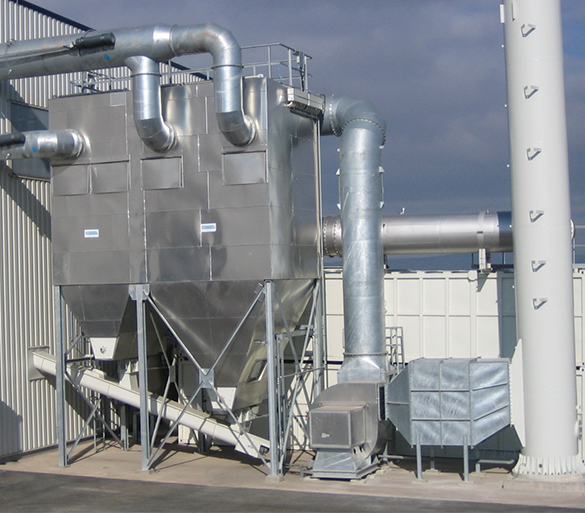In many incineration and industrial plants in various industries, as well as in municipal applications, dust emissions are produced during production processes. These emissions must be purified before they are released into the atmosphere. Those dusts can be sticky, wet, dry or combustible, have different particle sizes and are often loaded with pollutants. Industrial dusts are of different compositions and concentrations. Combinations with other pollutants are also possible – depending on the industry. In many municipalities and companies, dry dust separator systems are an efficient, cost-effective and, above all, long-term solution in order to achieve the specifications of the official regulations (e.g. German TA Luft).
Dry Dedusting Technology with fabric bag filters made from Wessel-Umwelttechnik have been used in many companies as well as in municipal plants since 1970 – and have thus proven themselves in many industries for over 50 years. Different designs and filter media are used. The choice depends on the individual requirements on site.
Depending on whether an antistatic, oleophobic, hydrophobic or other mode of action is required, the fibre materials of the bag filters are pre-treated accordingly. To ensure that the dry dust separator works properly and efficiently, the cleaning of the selected filter media is important. Wessel carries out the dry dust removal systems via bag filters with a compressed air cleaning system (so-called jet filters); in addition, knocking devices for the housing are used for dusts that tend to form bridges.
The exhaust air with dust is already pre-separated at the filter inlet by deflection and the impact effect. The remaining dust is deposited on the surface of the filter medium and must be regularly removed from there by compressed air blasts. This way, the separation efficiency remains consistent. The dust layer adhering to the membrane is cast off by the occurring overpressure.

The filter cleaning are controlled manually via controller or by an automatic control system. By using a differential pressure measurement device, the filter pressure loss is kept constant, the filter bags used are preserved and the compressed air consumption is kept to a minimum, especially in the case of changing dust levels. In addition, it is possible to further reduce the dust content of the clean gas by regulating the cleaning intensity.
In general, dry dust bag filters are used wherever large quantities of exhaust air and exhaust gases are generated and rather dry dusts are contained: as for example, in the wood industry, but also in the food or metal industry as well as in the municipal sector.

Low investment costs
The investment costs are lower compared to wet scrubbers. This makes them a good choice even for smaller industrial operations – as long as the exhaust air can be cleaned efficiently with the help of a dry dust separator. One of the regular costs of bag filter systems, however, is the filter bags. These must be replaced regularly, despite the periodic cleaning. This is the only way to ensure that cleaned air is fed into the environment in accordance with official regulations (e.g. German TA Luft).

Customised solutions
Due to the different designs and qualities of the filter bag material, the system can be used flexibly for different dusts depending on the conditions on site. This means that the filter that promises the highest degree of dust separation is always used. The filters available are fibre, felt and fabric filters in the form of bag, pocket and cartridge filters. The choice of the best possible filter depends on the quantity and composition of the dust, the operating volume flow, etc.

High safety standard
In the industrial sector, dusts pose a fire and explosion hazard – also in the process step of exhaust air cleaning. Wessel-Umwelttechnik focuses on consistently implementing the ATEX directives (2014/34/EU) in its dry dust bag filter systems. An extinguishing device with frost-proof spray water with C-connection is integrated into the separation systems in case of a fire in the filter. Certified bursting discs ensure that in the event of an explosion, pressure can be relieved via the separator system. A 180°-deflection also ensures that the explosion does not propagate in the return air pipe.
Dry separators are used wherever exhaust air and waste gases have to be cleaned of various dusts. For almost all industrial sectors and municipal applications where industrial exhaust air with dust and waste gases are generated, dust separators are an efficient and environmentally friendly solution.
These include:
